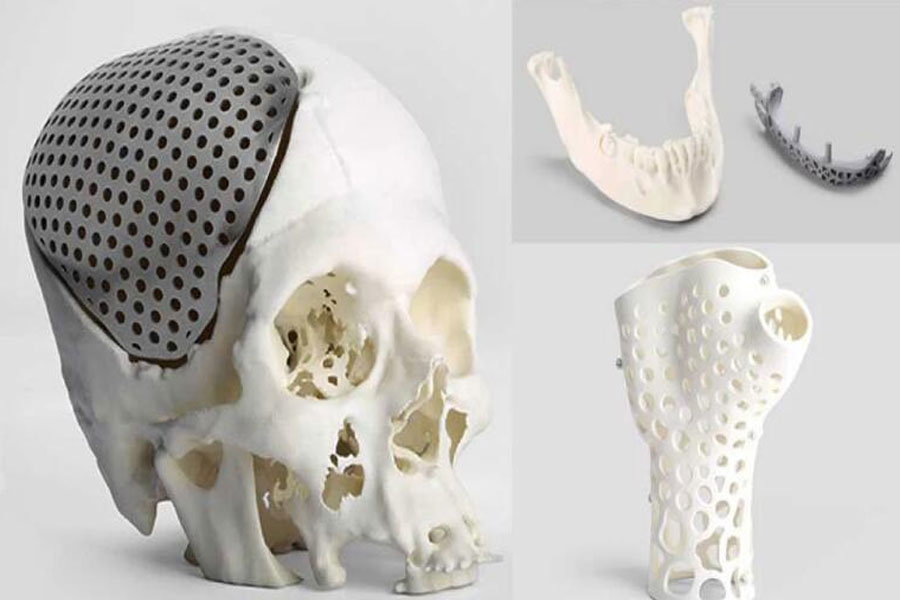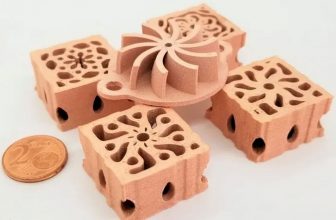
It is not uncommon for people to fracture or lose bones due to accidents or diseases. As a treatment method, doctors implant bone grafts or bone tissue fragments from the donor and fix them in place with wires and screws, which can help the body regenerate healthy bone structure.
Unfortunately, this process has some obvious flaws. First, the bone graft must be cut to accurately adapt to the position of the old bone. Second, if a metal plate or scaffold is inserted during an operation, surgical removal is usually required. Finally, for those who have lost a lot of bones, such as arms or legs, the most common choice is amputation.
3D printing bones can change all of this, making the process more natural and convenient. Doctors will no longer need to remove a bone graft from another bone or find a bone donor: they can simply scan the area and model the structure of the new bone.
With technical three-dimensional scanning and modeling, each implant can be accurately formed with the patient’s bones. Production speed is also very important. When looking to save a limb, this is another reason. 3D printing is a good candidate solution.
Once produced by a 3D printer, the bone can be implanted in the patient. Ideally, bone grafts will dissolve as new bone grows, reducing the need for more surgery. Although such bones can be printed with compounds similar to natural bones, researchers are also studying printing bones in other materials with special properties.
3D printed skull implant
Ciro, headquartered in Europe, specializes in the production of patient implants, including 3D printed bone implants. Based on the CT scan of the patient, the engineers and the surgeon design the implants so that they fit perfectly in the right position.
The Dutch company is developing a bone-like 3D printing material that contains calcium phosphate, which is a major compound in natural bone. Therefore, it will eventually merge with the patient’s existing bones and become part of it. This CT bone 3D printing material enables the implant to mimic the porosity of real bone.
This process is still being tested and is not yet available, but it shows great potential. Pre-clinical studies have shown that within 24 weeks, the implant will fuse with the patient’s bone. Later analysis showed that bone tissue and even bone marrow began to form during the transplantation process. Although this project has not had any news updates since 2018, we will pay close attention to it.
Super-elastic 3D printed bones
Materials scientist Northwestern University in Illinois, a new 3D printing material is called “super elastic bone” (HB). This flexible material is very beneficial because it can be cut, rolled, and is easy to use. Therefore, this material can be easily implanted during surgery.
Hb is composed of more than 90% hydroxyapatite, which is a compound that can enhance the real bone hardness. Combined with a special polymer, this brittle material becomes a flexible but consistent substance. It acts as a scaffold, encouraging the growth of blood vessels and cells with its porosity and absorbance.
This material is very promising because it will be an inexpensive solution to the problem of bone grafting. It is affordable to manufacture, can be 3D printed at room temperature, and stored for up to a year. For example, hospitals in developing countries can use this material without the need for expensive refrigeration systems.
In 2019, a study of live mice with skull defects. Hb has good bone regeneration ability. After 8 weeks, compared with other autologous bone implants, the effective rate is about 74%.
There are no human trials yet, but according to Dr. Shah, one of the conductors of this study, “Super-elastic bone has great potential and can be transformed into craniofacial reconstruction surgery. The demand for cost-effective bone grafts is huge.”
3D printed bone scaffold
Scientists at New York University are also developing their own 3D printed bones. Their goal is to help those in need, such as children with skull deformities or veterans who need a bone scaffold.
Scaffolding is a material designed for medical purposes to stimulate the formation of new organic tissues. They provide a physical structure for the development of tissues, and ultimately guide cells to grow to the desired shape and shape.
Scientists in New York are not flexible, but optimize healing by mimicking the shape and composition of bones. These bones are printed with β-tricalcium phosphate and then overheated to the final ceramic state. A special dipyridamole coating is added to the 3D printed part to accelerate new bone formation and attract bone stem cells.
Scientists from the University of East Anglia in the United Kingdom and the Animal Health Trust are developing 3D printing technology. A scaffold that supports horse bone regeneration.
3D printed hip replacement
3D printed bone parts are nothing new, at least not for hip implants. As early as 2007, Italian surgeons Grapiolo and Arkham (now part of GE) developed and successfully implanted the world’s first 3D printed acetabular component (hip cup).
The Delta-TT Cup is a hemispherical part that accommodates the femoral head, a component of the rotating ball, and allows the legs to move in multiple directions. The outer surface of the cup is attached to the patient’s buttocks and fixes the entire implant in place. This deliberately irregular surface 3D metal printing promotes bone adhesion and promotes the growth of cells between these parts.
For more than a decade, this Scandinavian 3D printer company has produced more than 100,000 hip cup implants, more than 600 implanted by Dr. Grappiolo himself.
Regarding durability, the Italian surgeon believes that this implant can sustain the patient’s entire life. Although there is no way to prove that Grapiolo’s first patient’s implant is still as powerful as the others.
3D printed skull implant mold
3D printing can help different forms of bone grafting. Instead of producing actual parts that will be implanted, creating molds for these parts can be a simpler but great solution in many cases.
Cranioplasty is the process of repairing the patient’s skull by adding implants, including organisms or composites, mainly for the purpose of protecting the brain and cosmetic surgery. In modern medicine, this is a well-known procedure, but it does bring challenges.
Commonly used materials are ceramics (hydroxyapatite) or polymers (PMMA). These medical-grade materials are usually in powder form and need to be sintered at high temperatures to obtain proper strength and then molded. The implant is modeled during the operation, and sintering usually has already occurred in the patient’s skull.
The problem here is that the high temperature required for sintering is very harmful to the brain of unprotected patients. This is the handwriting of 3D printing.
Through a CT scan of the patient, the implant is a model customized by the surgeon so that the model can be printed out of polymer. Then, the actual implant is the manufacturer who uses the mold before the operation, which not only avoids overheating, but also shortens the duration of the entire operation.
This is an incredible but cheap solution that is being used worldwide, especially in Europe, India, and Brazil. Very inspiring!
The use of 3D printers to make bone models, implants and molds can quickly produce more complex and anastomosed orthopedic products, reducing pressure for doctors and benefiting patients. Technologists are still constantly developing new 3D printing materials in order to achieve greater breakthroughs in the medical field.




